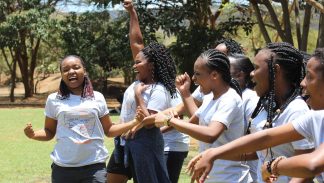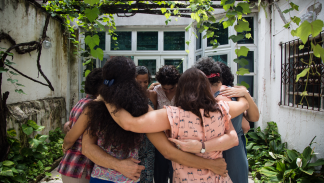Our new Movement Capacity Assessment Tool
Contributed by: PeiYao Chen, Kelly Gannon, and Lucy McDonald Stewart, Global Fund for Women’s Learning and Evaluation Team
Strengthening women’s rights movements is a key component of Global Fund for Women’s Theory of Change. We are charged with the task of figuring out how to meaningfully measure the progress of movement building. After two years of research, we developed the Movement Capacity Assessment Tool—an online tool that allows movement actors to assess the strengths, needs, and priorities of their movement and to use the results to develop action plans to strengthen movement capacity.
Currently in the pilot stage, the Movement Capacity Assessment Tool includes a series of questions that capture respondents’ perceptions of their movements along seven dimensions. According to social movements literature, these dimensions are key characteristics of a strong social movement, including (1) strong grassroots base, (2) strong leadership pipeline, (3) strong alliances, (4) collective political agenda, (5) use of multiple strategies, (6) support infrastructure, and (7) strong collective capacity to ensure safety and security of human rights defenders. It also captures the movement’s stages of development, because movements are always evolving. Movements that are just emerging have different capacity needs than mature movements, thus require different types of support.
As we test out the tool, we have had the opportunity to learn from and with activists, peer organizations, and others who are committed to social movements. Here are some of the key lessons learned so far:
1. Before launching an assessment, you need to first define the social movement you want to focus on
- Providing a clear definition and scope ensures that you invite the right people to participate and that the respondents are talking about the same social movement.
- Lack of scope or difficulty in defining the movement can signify pre-nascent movements or no movement at all.
2. Diversity of voices matters
- Because social movements are composed of diverse actors, our sampling approach focuses on including individuals and organizations representing different perspectives and playing different roles within the movement. These include leaders at the center of the movement as well as those at the margins.
- Diversity in perspectives should also consider generational differences. This might be a difference between the older and younger generations of activists, between more established and newer organizations, or between old-timers and newcomers in the movement.
3. The tool can be used to inform planning and to measure progress over time
- Results of the assessment can help movement actors and their supporters develop a shared understanding of where the movement is, what the capacity needs are, and develop action plans accordingly.
- Participants noted that the process provided space for them to reflect on their role in building movements. Some were motivated to re-engage with other movement actors to develop strategies to collectively address challenges.
4. The tool has limits
- It does not capture how different movements intersect, overlap, or exclude one another.
- It does not provide a comprehensive landscape analysis of a social movement, though it may help identify new or unknown actors.
After we complete the pilot project, we plan to make the tool available to the public. If you are interested in helping us test the tool, please email Kelly at [email protected].
A version of this article was published by the American Evaluation Association on the AEA365 blog.


